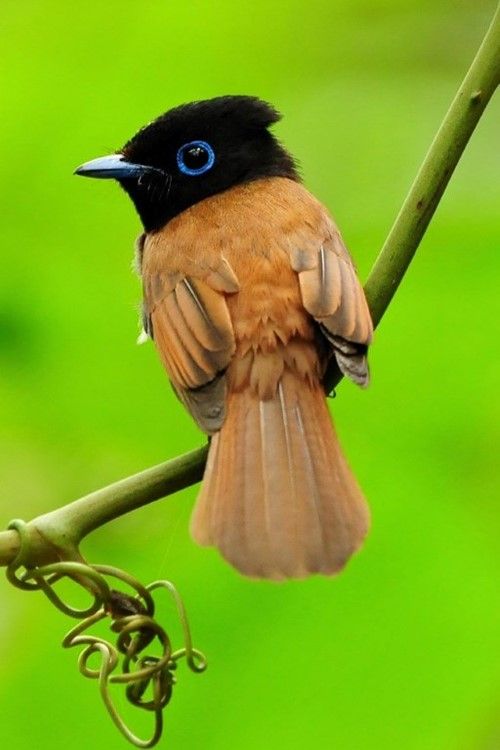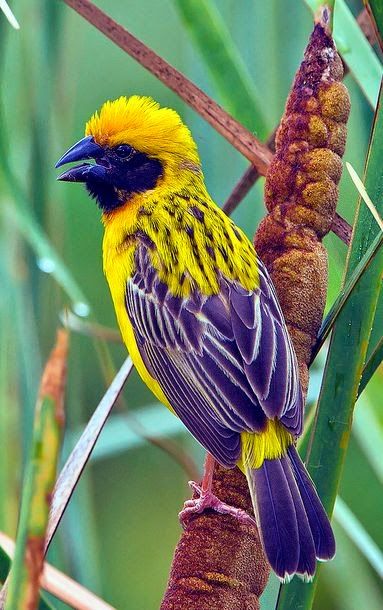Asian Paradise Flycatcher
The Asian paradise flycatcher (Terpsiphone paradisi) is a medium-sized
passerine bird native to Asia. Males have elongated central tail
feathers, and in some populations a black and rufous plumage while
others have white plumage. Females are short-tailed with rufous wings
and a black head. They feed on insects, which they capture in the air
often below a densely canopied tree.
Diederik Cuckoo
The diederik cuckoo, formerly dideric cuckoo or didric
cuckoo, and sometimes called Diederik's cuckoo, is a member of the
cuckoo order of birds, the Cuculiformes, which also includes the
roadrunners, the anis, and the hoatzin.
Scientific name: Chrysococcyx caprius
Rank: Species
Higher classification: Chrysococcyx
Scientific name: Chrysococcyx caprius
Rank: Species
Higher classification: Chrysococcyx
Asian Golden Weaver Male
The Asian golden weaver (Ploceus hypoxanthus) is a species of bird in
the Ploceidae family. It is found in Cambodia, Indonesia, Laos, Myanmar,
Thailand, and Vietnam. Its natural habitats are subtropical or tropical
seasonally wet or flooded lowland grassland, swamps, and arable land.
It is threatened by habitat loss.
Gray Hawk - 1st Record For California
A Santa Barbara birder saw a hawk perched on a
wire in Carpinteria, California, November 25, 2012 and photographed it.
He didn't recognize it as one of the local resident hawks and consulted
with others as to the identity of this hawk, and it turned out that it
was a juvenile Gray Hawk in its 2nd or 3rd year. This bird was a true
vagrant and the 1st documented California record. The nearest area where
this bird can be found in any numbers is Southern Arizona, Truly, this
hawk was a long ways from home. It remained at this location into 2013
and then disappeared just before spring. Speculation was, would it
return in the coming winter, and low and behold it did, and spent the
winter of 2013 and 2014. Again it disappeared and everyone wondered. It
again showed up in December, and is on course to spend the winter of
2014 and 2015. Not only did it return for the 3rd winter, it's in the
same exact area where it was first found and photographed.
Holland Honeyeater Bird
It is mostly black and white, with a large yellow wing
patch and yellow sides on the tail. It has a small white ear patch, a
thin white whisker at the base of the bill and a white eye. This
honeyeater is an active bird, and rarely sits still long enough to give
an extended view. Females are slightly smaller in size. Young birds are
browner and have a grey eye. It's range extends throughout southern Australia, from about Brisbane, Queensland, to just north of Perth, Western Australia.
Hyacinth Macaw
The hyacinth macaw, or hyacinthine macaw, is a parrot
native to central and eastern South America. With a length of about 100
cm it is longer than any other species of parrot. It is the largest
macaw and the largest flying parrot species, though the flightless
kakapo of New Zealand can outweigh it at up to 3.5 kg. While generally
easily recognized, it can be confused with the far rarer and smaller
Lear's macaw. Habitat loss and trapping wild birds for the pet trade has
taken a heavy toll on their population in the wild, and as a result the
species is classified as endangered on the International Union for
Conservation of Nature's Red List, and it is protected by its listing on
Appendix I of the Convention on International Trade in Endangered
Species of Wild Fauna and Flora.
The Striking Scissor-Tailed Flycatcher is Only Regular “Long-Tailed Kingbird”.
The
striking scissor-tailed flycatcher is our only regular “long-tailed kingbird.”
But it is not only elegant and attractive, but also common and easy to
observe. The splendid scissor-tailed
flycatcher (Tyrannus forficatus), also recognized as the Texas bird-of-paradise
and swallow-tailed flycatcher, is a long-tailed bird of the genus Tyrannus,
whose members are collectively referred to as kingbirds. Well, the kingbirds
are a group of large insectivorous (means insect-eating) birds in the tyrant
flycatcher (Tyrannidae) family. The scissor-tailed flycatcher can be found in
North and Central America. This bird was also famous with its former Latin name
“Muscivora forficate”. The former genus word, “Muscivora” actually derives from
the Latin word for "fly" (musca) and "to devour" (vorare),
while the species name forficata derives from the Latin word for
"scissors" (forfex). The long scissortail bird is now considered to
be a member of the Tyrannus, or "tyrant-like" genus. This genus
earned its name because quite a few of its species are exceptionally aggressive
on their breeding territories, where they will feel no hesitation to attack on
larger birds such as crows, hawks and owls.
Moreover,
adult birds have pale gray heads and their upper parts, light underparts,
salmon-pink flanks and under tail coverts, and dark gray wings. Axillars and
patch on underwing coverts are red. The bird’s species extremely long, forked
tails, which are usually black on top and white on the underside, are
characteristic and unique. At maturity, the male may be up to 15 inches in
length, though the female's tail is up to 30 percent shorter. The wingspan is
15 cm and the weight is up to 43 g. Further, Lmmature birds are duller in color
and have shorter tails, whereas a lot of these birds have been reported to be
more than 40 cm. The male and
female travel together throughout their territory in search of a nest place in
open prairie, mesquite prairie, parks, gardens, pastures, croplands, roadsides
or saltmarsh edges. When they discover a potential nest site in an isolated
tree or shrub, they both hop around and test out diverse spots by pressing
themselves against the branches. They normally select an open site that’s
sheltered from the prevailing wind and often shaded by some foliage. These birds build a cup nest in isolated trees or shrubs, sometimes
using artificial sites such as telephone poles near towns. The male bird
performs a huge aerial display during courtship with his long tail forks streaming
out behind him. Both species feed the young bird and like other kingbirds,
they’re extremely aggressive in defending their nest. Normally these birds’
clutches contain 3 to 6 eggs.
In the
summer season, scissor-tailed flycatchers feed mostly on insects i.e., grasshoppers,
robber-flies, and dragonflies, which they may catch by waiting on a perch and
then flying out to catch them in flight. If they need extra food in the winter
season, they’ll also eat some berries. The bird breeding habitat normally in open
shrubby country with scattered trees in the south-central states of Texas,
Oklahoma, Kansas; western portions of Louisiana, Arkansas, and Missouri; far
eastern New Mexico; and northeastern Mexico. It is reported sightings record
occasional stray visitors as far north as southern Canada and as far east as
Florida and Georgia. The birds migrate through Texas and eastern Mexico to
their winter non-breeding range, from southern Mexico to Panama. Moreover, pre-migratory
roosts and flocks flying south may comprise as many as 1000 birds. The lovely
scissor-tailed flycatcher is the state bird of Oklahoma, and is displayed in
flight with tail feathers spread on the reverse of the Oklahoma Commemorative
Quarter. The Scissor-Tailed Flycatchers have the habits of having several human
products in its nest, such as string, cloth, paper, carpet fuzz, and cigarette
filters. Well, this beautiful Scissor-tailed Flycatcher numbers are a small
decline between 1966 and 2010, however, according to the North American Breeding
Bird Survey. A decline was noted in the mid-1970s, which was offset by an
increase in numbers during the 1980s. Moreover partners in Flight estimates a
global breeding population of 9.5 million with 92 % breeding in the United
States., and 50 % spending some part of the year in Mexico.
Subscribe to:
Posts (Atom)

















